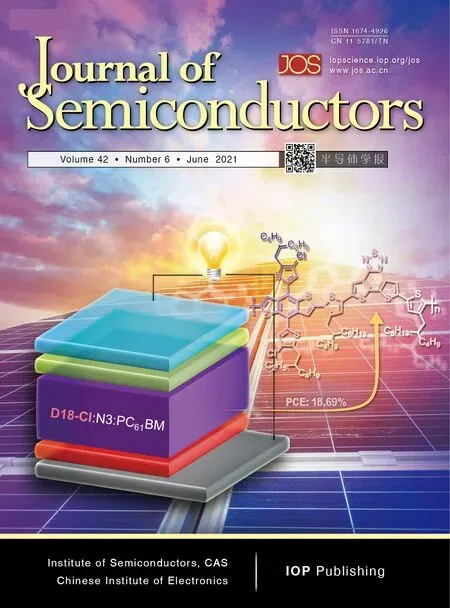18.69% PCE from organic solar cells
Ke Jin, Zuo Xiao, and Liming Ding
Center for Excellence in Nanoscience (CAS), Key Laboratory of Nanosystem and Hierarchical Fabrication (CAS), National Center for Nanoscience and Technology, Beijing 100190, China
The exquisite design and persistent development of fused-ring-acceptor-unit-based copolymer donors and Y-series nonfullerene acceptors (NFAs) have pushed the power conversion efficiencies (PCEs) for organic solar cells onto the 18% level[1−21].Our group invented copolymer donors D18 and D18-Cl[2,3].D18:Y6, D18-Cl:N3 and D18:N3 solar cells have delivered outstanding PCEs of 18.22%, 18.13% and 18.56%, respectively[2−4].Ternary solar cells based on a polymer donor, a NFA and a fullerene acceptor show great potential since they combine good light-harvesting capability of NFA and good electron-mobility of fullerene[5].
In this report, the device structure is ITO/PEDOT:PSS/D18-Cl:N3:PC61BM (D:A1:A2)/PDIN/Ag.The D:A1ratio was fixed at 1:1.4 (wt) since D18-Cl:N3 cells gave the best performance at the ratio of 1:1.4[3].We adjusted PC61BM content from 0.1 to 0.2 to 0.3.When D:A1:A2ratio was 1:1.4:0.1, the ternary cells gave the highest PCE (Table S1).The champion cells with 0.3 vol% diphenyl ether (DPE) as the additive and an active layer thickness of 114 nm gave the highest PCE of 18.69%, with an open-circuit voltage (Voc) of 0.849 V, a shortcircuit current density (Jsc) of 28.22 mA cm–2and a fill factor(FF) of 78.0% (Table S2, Table S3 and Fig.S1).The external quantum efficiency (EQE) exceeded 80% in 450–840 nm, with a maximum of 91% at 540 nm (Fig.S2).The integrated photocurrent density is 27.24 mA cm–2.The best devices were also measured at the National Institute of Metrology (NIM),Beijing, and a certified PCE of 18.1% (Voc, 0.854 V;Jsc, 27.36 mA cm–2; FF, 77.3%; effective area, 2.580 mm2) was recorded(Fig.S3).To the best of our knowledge, the 18.1% certified efficiency is the highest value reported for organic solar cells to date.Compared with the binary cells, the ternary cells show simultaneously enhancedJscand FF, suggesting the improved charge transport in the active layer.We measured hole and electron mobilities (μhandμe) by using the space charge limited current (SCLC) method (Fig.S4, Fig.S5 and Table S4).From binary to ternary blend films,μhdidn’t change much whileμeincreased from 6.32 × 10–4to 7.42 ×10–4cm2V–1s–1.Fullerene enhanced electron transport and led to more balanced charge transport (Table S4).
Acknowledgements
We appreciate the National Key Research and Development Program of China (2017YFA0206600) and the National Natural Science Foundation of China (51773045, 21772030,51922032, 21961160720) for financial support.
Appendix A.Supplementary material
Supplementary materials to this article can be found online at https://doi.org/1674-4926/42/6/060502.
 Journal of Semiconductors2021年6期
Journal of Semiconductors2021年6期
- Journal of Semiconductors的其它文章
- Oscillation neuron based on a low-variability threshold switching device for high-performance neuromorphic computing
- A 3.3 kV 4H-SiC split gate MOSFET with a central implant region for superior trade-off between static and switching performance
- Determination of trap density-of-states distribution of nitrogendoped ultrananocrystalline diamond/hydrogenated amorphous carbon composite films
- 3.3 kV 4H-SiC DMOSFET with a source-contacted dummy gate for high-frequency applications
- Heavily doped silicon:A potential replacement of conventional plasmonic metals
- Modeling the photon counting and photoelectron counting characteristics of quanta image sensors
